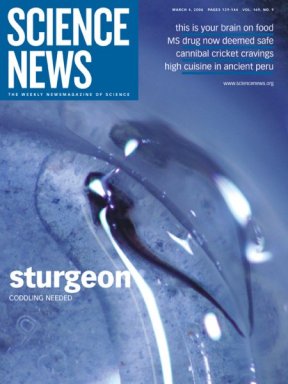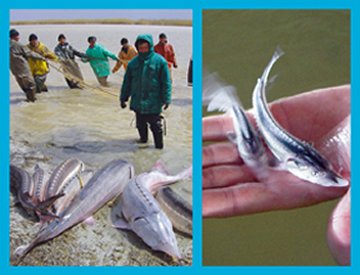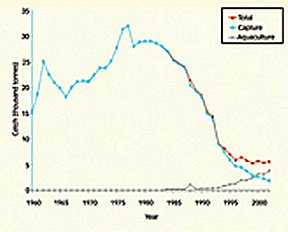Saving Sturgeon
Ancient fish face increasingly tough times
On a fine spring day alongside a Wisconsin river, several biologists wrestle a muscular, 120-pound fish onto her back and straddle her. The moves wouldn’t be out of place in a rodeo. As the team restrains her, one member massages her swollen belly, working her eggs out of a release vent and into a plastic pail. The late-April scene occurs as, throughout the northern Midwest, water temperatures climb above 56°F (13°C) and lake sturgeon swim upstream to spawn. In several rivers, biologists such as these give Mother Nature an assist.




“This is the highlight of my year,” says Steven J. Fajfer, who supervises propagation of lake sturgeon for the Wild Rose (Wis.) Fish Hatchery.
His team starts by netting several males, each about 20 pounds and 4 feet long. Gentle hands slide down each animal’s belly to eject its sperm before the fish is returned to the water, Fajfer explains.
Then, the real heavy lifting begins. The researchers scout for a 55- to 75-inch female of this species (Acipenser fulvescens) splashing along cobbled edges of the river. After hoisting her ashore, the biologists apply their rodeo moves to extract her eggs and then return the big mama to her stream.
Fajfer or one of his colleagues divides her eggs among a series of buckets and adds water and the freshly collected sperm. For the next 2 to 4 minutes, he explains, “we’ll gently stir the eggs with our hands”—until they turn sticky, a sign that the eggs are fertilized. Later, the eggs are hauled to the hatchery where the young will emerge and be coddled for up to a year. Finally these juveniles and those from other rivers will be released, most into their natal streams.
Globally, many wild sturgeon get their start in life with substantial human help. The heroic interventions are likely to increase as populations of sturgeon species, precarious everywhere, continue to spiral downward.
Today, most sturgeon populations exist as tiny fragments of their abundance just 30 years ago, and many populations face possible—even probable—extinction. The caviar trade has driven overfishing, but environmental changes also threaten sturgeon survival.
“It’s not too late to save most sturgeon species,” says Ellen K. Pikitch of the Pew Institute for Ocean Science in Miami. However, doing so will require large investments in captive rearing, law enforcement, political action, and research. “It won’t be easy,” she says.
Living fossils
For some 200 million years, sturgeon have been cruising the planet’s rivers and seas, notes Phaedra Doukakis of the Pew Institute’s New York office. The 25 species remaining today don’t look much different from their Jurassic ancestors.
All still have mouths at the bottom of their snouts and thin beards of whiskerlike barbels that can detect trace concentrations of waterborne chemicals.
Like the skeletons of similarly ancient sharks, a sturgeon’s frame is made of cartilage, not bone. However, running from behind a sturgeon’s gills to its tail fins are five rows of sharp, diamond-shaped bumps. Called skutes, these bumps are bone protruding through the fish’s skin, explains sturgeon physiologist Molly A.H. Webb of the Bozeman (Mont.) Fish Technology Center.
Sturgeon also resemble sharks in that they mature slowly. Males may be 12 years old and females 25 years old before they spawn for the first time. Then, the individual won’t spawn again for 3 to 5 years. This rate of reproduction is slow, but it can continue for up to 60 years.
Sturgeon share reproductive characteristics with both fish and amphibians, Webb notes. For instance, frog sperm have an acrosome, a structure that releases enzymes that penetrate the outer membrane of eggs during fertilization. Fish eggs, in contrast, have a tiny hole—a micropile—that a sperm must find and enter. Sturgeon show both acrosomes and micropiles.
Also unique: Males have vestigial oviducts—channels for moving eggs—notes Diana Papoulias of the U.S. Geological Survey in Columbia, Mo. Moreover, she observes, unlike in other fish, the “oviducts” in both males and females are unconnected to the gonads.
There’s plenty that biologists still don’t know about reproduction in these fish. Those data gaps make it difficult for caviar harvesters, hatchery managers, aquaculture operators, and conservation biologists to be effective.
Black pearls
Because caviar—sturgeon roe—commands up to $150 per ounce, connoisseurs expect quality eggs. Although sturgeon fishers could, in theory, harvest the pearly black roe as Fajfer’s team does, the product wouldn’t taste good, observes Serge I. Doroshov of the University of California, Davis. Biochemical processes associated with ovulation induce off flavors and alter the texture of the roe.
“So, to get caviar,” he explains, “you have to extract the entire ovaries, killing the fish.”
Today, legal harvests of wild sturgeon total some 3,000 metric tons (t) per year—down from a 1977 peak of more than 30,000 t, according to a survey of sturgeon trends reported by Pikitch, Doukakis, and their colleagues in the September 2005 Fish and Fisheries. This decline represents diminishing stocks of fish throughout the Northern Hemisphere, not less fishing, the researchers say.
They also point out that these tallies don’t include illegal harvests. According to data reported late last year by Switzerland and the European Union, policing agencies in Europe have seized 12 t of illegal caviar since 2000. Since that egg tonnage represents fish carcasses rivaling the annual tonnage of fish caught legally, poaching probably exceeds legal harvests, Pikitch concludes.
Her team examined the sturgeon catches from 70 percent of the major fisheries in the world. The scientists found a drop of at least 85 percent from peak production.
Wild harvests are prohibited for several of the sturgeon species most endangered with extinction, such as the pallid (Scaphirhynchus albus).
On Jan. 3, officials administering the Convention on International Trade in Endangered Species (CITES), announced that the treaty will from now on prohibit international commerce in all sturgeon from the Caspian Sea basin, the Black Sea–lower Danube River basin, and the Amur River basin of Russia and China.
A trade ban from these basins—the world’s major caviar-exporting areas—must now be enforced by all of CITES’ 169 signatory nations, including the United States. The restrictions remain in effect in each basin until the exporting nations there agree on quotas and management programs and supply data to CITES showing that their fishing and research activities aren’t jeopardizing sturgeon populations, says David H.W. Morgan, who heads scientific support at CITES’ headquarters in Geneva.
The ban doesn’t, however, apply to farmed sturgeon.
Farm-fresh eggs
Over the past 2 decades, enterprising aquaculture developers anticipated the current wild-sturgeon shortage and took up farming the caviar producing fish. Today, three such farms for white sturgeon (Acipenser transmontanus) are operating successfully outside Sacramento, Calif.
Aquaculturists there started in the early 1990s with 200 locally caught fish. The farms today annually produce close to 10 t of caviar, roughly equivalent to Russia’s legal harvest of wild roe, says Doroshov, who has been a consultant since the project began.
Caviar production has proved “very artisanal,” he notes. A roe harvest’s flavor and texture depend on what the fish has eaten, the temperature and quality of the water it lived in, and how the eggs were processed after harvest. It’s taken a while, but caviar from these farms has come to impress importers enough that the product is now sold throughout Europe at prices near those for wild roe.
The Mote Marine Laboratory in Sarasota, Fla., has been investigating aquaculture of a different fish, the Siberian sturgeon (Acipenser baeri). The lab’s commercial-scale demonstration tanks now house 65 t of sturgeon—including some 24,000 weighing at least a pound.
Mote’s oldest female Siberian sturgeon are now 5 years old, “and we’re expecting some caviar this year,” says project leader Jim Michaels. With their customized food and accommodations, farmed sturgeon mature at roughly triple the rate of wild fish.
A side benefit of sturgeon farming, Michaels and Doroshov note, is that the study of fish in aquaculture is paying rich dividends in knowledge about the biology of wild stocks too imperiled for researchers to capture for examination.
Stressed sick
While overfishing has historically posed the greatest threat to sturgeon species, several environmental trends are also seriously stressing stocks, even some that are no longer fished.
A biological imperative drives spawning sturgeon to swim far upstream from the ocean, inland sea, or lake that they inhabit while they’re not spawning. Over the past 150 years, however, people have been altering rivers. Some portions are deepened and straightened to facilitate barge traffic; others are dammed. These public works projects are now haunting government agencies charged with protecting sturgeon, notes Webb.
For instance, reshaping shipping channels removes slow-current areas where sturgeon feed. Altered rivers can also scour away the bottom-dwelling animals that the fish consume. Dams gate off some spawning regions, collect silt that buries previously rocky sturgeon haunts, and limit how well a river flushes out pollutants.
Scientists are beginning to see effects of these changes. For instance, fisheries biologist Grant W. Feist at Oregon State University in Corvallis and his colleagues examined 174 near-mature white sturgeon hauled in during sport fishing on various stretches of the Columbia River. Fish in one section had access to the ocean; the rest were separated from the ocean by dams. Sturgeon that never have access to the ocean still move upriver to spawn. In the December 2005 Environmental Health Perspectives, the team reports disturbing anomalies in some fish, especially those trapped within dammed segments of the river.
Blood from fish in the impounded stretches, especially from those behind the largest dam, tended to exhibit the highest concentrations of DDT, polychlorinated biphenyls, and other pollutants.
Immature females behind two smaller dams had much more vitellogenin, an egg-yolk protein, in their blood than the scientists had expected. Males, which normally have no vitellogenin, also showed measurable concentrations. Such an inappropriate feminization of males and young females has been witnessed in other fish species exposed to industrial, agricultural, and pharmaceutical pollutants (SN: 12/10/05, p. 381: Available to subscribers at Feminized cod on the high seas). Three sturgeon also carried both mature ovaries and mature testes, something that’s never observed in normal fish.
Enzyme concentrations in the most-tainted fish indicated that their livers were fighting toxins in the animals’ bodies. However, one of the enzymes also breaks down male sex hormones. Feist told Science News that this would suggest that if the condition persists once the males reach maturity, they “won’t be able to produce sperm.”
Halfway across the continent, in polluted stretches of the Missouri and Mississippi rivers, Papoulias sees disturbing numbers of “major reproductive pathologies” in adult shovelnose sturgeon (Scaphirhynchus platorynchus). Some males had testes full of sperm and also ovaries riddled with mature eggs. Some females’ eggs were undergoing cell division although they hadn’t been fertilized by sperm. A few females hosted tumors—ones likely triggered by inappropriate egg activation. Still other females were resorbing eggs, as the fish do when they’re stressed or can’t spawn.
Papoulias has unearthed a handful of reports by other scientists chronicling similar impairments in the region’s shovelnose sturgeon. “What’s scary,” she says, “is that the incidence of these changes appears to be rising.” In the shovelnose species, 10 percent or more show major reproductive abnormalities.
She has described her findings to sturgeon researchers overseas. “My Russian colleagues don’t even raise an eyebrow,” she observes. “They say that they see reproductive abnormalities and tumors all of the time, usually in very polluted regions.”
Sturgeon prospects
One might expect that the new caviar ban would immediately give sturgeon a respite from overfishing. However, many biologists are pessimistic.
Pikitch has worked with sturgeon-conservation programs in central Asia. She says that many sturgeon-exporting nations are too poor to police poaching, much less monitor the health of sturgeon stocks in a scientific manner.
Moreover, notes Morgan, some sturgeon hatchery-and-restocking programs are financed in part by taxes on caviar sales. “So, you could have a catch-22 situation,” he says. Severely curtailed trade will dry up the money for restocking as poaching soars.
Another limitation on the ban’s effectiveness is that illegally caught caviar might be branded as a farmed product, Morgan notes.
Eight years ago, Doukakis and her colleagues performed genetic tests on caviar purchased in New York City. Somewhere between 25 and 30 percent of the time, caviar had been mislabeled with respect to species,” she says. Sometimes, caviar of a highly endangered species was labeled as a species that was legal to capture.
What’s more, wildlife inspector Sheila Einsweiler of the U.S. Fish and Wildlife Service in Arlington, Va., says that state officials are reporting an effect on U.S. sturgeons in response to CITES’ pressure on the Caspian and Black Sea caviar trade. There’s been an increase in the legal harvest of U.S. stocks, she says, as well as a boost in illegal catches.
“The United States is going to have to step up enforcement efforts to prevent pressures caused by the new ban,” Pikitch says. However, she adds, “we can’t give up working directly in the Caspian and other exporting regions to ensure survival of their sturgeon in the wild.”
“Clearly,” she concludes, “we have to remain vigilant on all fronts.”






